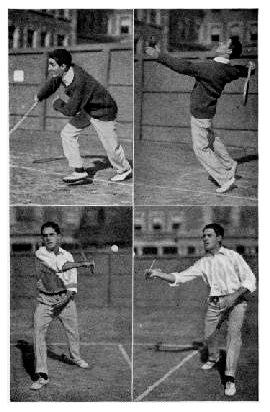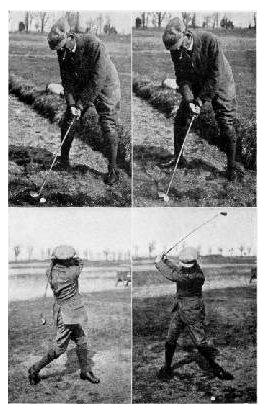
OUTDOOR SPORTS AND GAMES
BY CLAUDE H. MILLER, PH.B.
XVII
LAWN TENNIS AND GOLF
How to make and mark a tennis court—Clay and sod courts—The proper grip of the racket—Golf—The strokes and equipment
The steady growth in popularity of lawn tennis as well as the splendid exercise that results from playing this game has given it a sure place in the field of athletic sports. It is a game that requires a great deal of skill, and as no one realizes this fact more than those who are experts, a beginner should not be deterred from playing tennis simply because he may fear the criticism of the more experienced. The only way to learn the various strokes and to be able to play a good game is to practise at every opportunity. It is better to play against some one who is more skilful than ourselves and who will keep us on our mettle to make a good showing.
The eye and the muscles must work automatically and with precision. No amount of written instructions can give us this skill. The personal outfit for playing tennis is of course very simple. Every player should own his racket and become accustomed to it. They cost almost any price up to eight dollars, which will buy the very best rackets made. The weight and size of the racket will depend on our strength. The average weight for a man is about fourteen ounces and for a boy an ounce or two lighter. A skilful player becomes so accustomed to the feeling and weight of his own racket that often he will play an indifferent game if he is forced to use any other.
The game of lawn tennis was first played on a lawn or grass court, and many players still prefer this kind of a court, but the difficulty of obtaining a good sod, and after having obtained it the greater difficulty of keeping it in good condition, have increased the popularity of a skinned or clay court, which is always in fair condition except immediately after a heavy rain. The expense of maintaining a tennis court is more than most boys or most families would care to undertake.
As a rule, tennis courts fall in the same general class with golf links in that they lend themselves readily to the joint ownership of a club or school, where the expense falls on a number rather than on an individual. In a great many places the boys of a town or village have clubbed together and have obtained permission from some one owning a piece of vacant ground that is not likely to be sold or improved within a few years and have built a tennis court on it. This arrangement helps the appearance of the land, that should be secured at a very low rental, or none at all if the owner is public spirited and prefers to see the boys of his town grow up as healthy, athletic men rather than weaklings who have no place for recreation but in the village streets, where passing trucks and automobiles will endanger their lives, or at least cause them to be a nuisance to the public.
 The dimensions of a tennis court
The dimensions of a tennis court To build a tennis court properly means a lot of work and it should only be attempted under the direction of some one who understands it. The things most important are good drainage, good light, and sufficient room. A double court is 36 feet wide by 72 feet long, but in tournament games or on courts where experts play it is customary to have an open space about 60 feet wide by 110 to 120 feet long, to give the players plenty of room to run back and otherwise to play a fast game. A court should always be laid out north and south or as near these points of the compass as possible. In courts running east and west the sun is sure to be in the eyes of one of the players nearly all day; this is of course a very serious objection. While it is very pleasant to play tennis in the shade of a tree or building, a court should never be located under these conditions if it is possible to avoid it. A properly placed court should be fully exposed to the sun all day.
First of all it will be necessary to decide whether a grass or "dirt" court is to be built. If the grass is fine and the place where the court is to be happens to be level, there is little to do but to cut the sod very short with a lawn-mower and to mark out the court. If, on the contrary, there is much grading or levelling to be done, a dirt court will be much cheaper and better in the end, as constant playing on turf soon wears bare spots. The upkeep of a grass court will be expensive unless it is feasible to move its position from time to time.
Whatever the court is to be, the first question to consider is proper drainage. If the subsoil is sandy the chances are that the natural soakage will take care of the surplus water, but on the contrary, if the court is at the bottom of a hill or in a low place where clay predominates, it is necessary to provide some means of getting rid of the surplus water from rainfalls or our court may be a sea of mud just when it would be most useful to us. To level a court properly we shall need the services of some one expert with a levelling instrument of some kind. It is not safe to depend on what seems to be level to our eye, as our judgment is often influenced by leaning trees, the horizon, and other natural objects. With a few stakes driven into the ground, the tops of which are level, we are enabled to stretch lines which will give us our levels accurately.
A court should have a slope of a few inches from one end to the other to carry off water. After the level is determined, all there is to making a court is to fill in or cut away soil and earth until the proper level space is obtained. As a rule it is better to dig away for a court rather than to fill in, as we thus obtain a better bottom and one that will require but little rolling. In the case of a slope, it is well so to locate the court that the amount of earth excavated from one end will be just about sufficient to fill in the other.
The final surfacing of a court is done by means of clay and sand in the proportion of about four or five to one, the clay of course being in excess. To mix clay and sand thoroughly, the former should first be pulverized thoroughly when dry and the mixture sifted over the court carefully and evenly. The next step is rolling and wetting, and more rolling and wetting until finally the whole is allowed to dry and is ready for play. The slight irregularities and roller ridges that often appear in a court will soon be worn off by the players' feet, but playing of course will not change the grade. A new court will be greatly improved by use, but no one should be allowed on a court except with rubber-soled shoes. Heeled shoes will soon ruin a court, and it is bad practice even to allow any one to walk over a court unless with proper footwear.
The preliminary levelling of a court can be accomplished with a rake and a straight-edged board, but after the clay has become packed and hard it will be necessary to use considerable force in scraping off the inequalities. A metal cutting edge, such as a hoe or scraper, will be found useful. A court should be swept with a coarse broom to distribute the fine material evenly. Another very good sweeper can be made from a piece of wood about six or eight feet long to which several thicknesses of bagging have been tacked or fastened. The final step in making a court consists in marking it out. Most courts are marked so that they will be suitable either for singles or doubles or so that either two or four people can play at a time. Where tape markers are to be used, the proper distances will appear on the tape without measuring, but if lime is used for marking a careful plotting will be necessary to secure the proper distances, after which the corners should be indicated by angle irons, so that the court may be re-marked at any time without re-measuring.
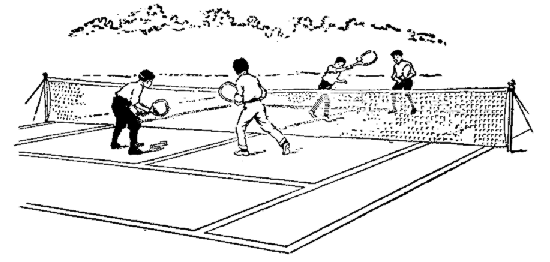 A game of doubles in lawn tennis
A game of doubles in lawn tennis Considerable difficulty is often experienced by beginners in marking out a court, and, in fact, it is not a simple matter. The first thing of importance is to determine generally one corner of the court and to get a base line and a side line at a true right angle of ninety degrees. The same principle may be employed that is used by builders and surveyors in "squaring a building," as it is called. You will need a ten-foot pole with marks for the feet indicated on it in lead pencil, and in addition to this a few 20-penny spikes and a ball of stout twine. Drive a nail into the ground where you want one corner of the court and fasten the line to it; then stretch the line to another nail to mark either a side line or back line. You will then have one side and the corner fixed, and the problem is to get another line at right angles to it. Boys who have studied geometry know that "in a right-angle triangle the square of the hypotenuse is equal to the sum of the squares of the other two sides." It isn't necessary to understand this, but it is the principle employed in "squaring." You next stretch another line and have some one hold it. On the fixed side line you measure eight feet from the corner nail and mark it with a piece of twine tied around the line. You also make a six-foot mark on the line to be at right angles to it, the exact direction of which is yet to be determined. Both of these measurements must be accurate. The boy on the end of the loose line moves it until the distance between the two pieces of twine is exactly the length of your ten-foot pole. The angle thus formed is exactly ninety degrees, or a right angle. Having obtained one side and one end, to finish marking is simply a matter of making the necessary measurements of a court as shown on the diagram and marking each intersecting point with a nail driven into the ground.
 How to mark out a tennis court
How to mark out a tennis court Another way to lay out a court is to drive two stakes or nails into the ground 27 feet apart. (The line of these stakes should be the position of the net.) Then take two pieces of twine, one 47 feet 5 inches long, and the other 39 feet. Fasten one line to each of the spikes that you have placed 27 feet apart. Where the two lines meet as they are pulled taut are the true corners of the court, as there are only four points where they can meet. The various measurements can then be marked as above by referring to the diagram. It is customary to mark a double court and to indicate the lines for singles afterward.
The game of tennis may be played either by two or four persons, or sometimes an expert player will stand two beginners. The ball used is rubber filled with air and covered with white felt and is 2 1/2 inches in diameter. It is necessary to play with two balls, and to save time in chasing those that go wild it is customary to play with three or four.
One of the players begins by serving. The selection of the court is usually chosen by lot or by tossing up a racket in a way similar to tossing a cent. The side of the racket where the woven gut appears is called "rough," and the other side "smooth." This practice is not to be recommended, as it injures the racket. It is better to toss a coin. The game of tennis consists in knocking the ball over the net and into the court of your opponent, keeping up this volley until one side or player fails to make the return properly or at all, which scores his opponent a point. While a game in tennis consists of four points, the simple numbers from one to four are not used. The points run 15,30, 40, game, when one side makes them all. Or it may be "15-30," "15 all," and so on, the score of the server being mentioned first. Where one side has nothing their score is called "love." When one side has scored four points the game is won—with this exception: When both sides are tied at 40, or "deuce," as it is called, the winners must make two points more than their opponents to win. In this way the game may be continued for a long time as the points are won first by one side and then by the other. The score at deuce, or "40 all," will be denoted as "vantage in" or "vantage out," depending upon whether the server's side or the other wins one of the two points necessary to win from "deuce." If first one side, then the other, obtains one of these points the score will be "vantage in" or "out," as the case may be, and then "deuce" again, until finally when two points clear are made it is "game." A set of tennis consists in winning six games, but in this case also there is a peculiar condition. Where each side wins five games it is necessary in order to win the set to obtain a lead of two games. The score in games is then denoted just as in a single game, "deuce" and "vantage" games being played until a majority of two is won.
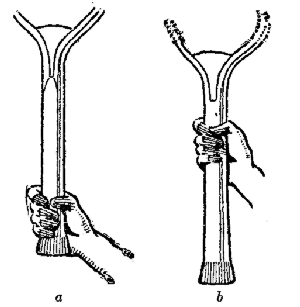 (a) the right and (b) the wrong way to hold a tennis
racket
(a) the right and (b) the wrong way to hold a tennis
racket To learn the game of tennis, first obtain a proper grip of the racket. It should always be held firmly and as near the end as possible, the leather butt being inside the hand. A loose grip will absolutely prevent a player from becoming expert, as the accuracy and quickness that are a part of tennis can never be obtained unless we have the racket under perfect control. The various backhand, high and low strokes will only come from constant practice. The most important stroke to master as well as the most difficult is a swift, accurate service. A player who is otherwise a fair player can easily lose game after game by not having mastered his service stroke, and thus he beats himself without any effort on the part of his opponent. The various "twist" services have almost passed out of use. Even the best players employ a straight, swift overhand ball. To fail to serve the ball over the net and in the proper place is called a "fault." The player has two chances and to fail in both is called "a double fault." A common mistake is to attempt a swift smash on the first ball, which may fail half the time, and then to make sure of the second ball by an easy stroke which a skilful opponent can return almost at will and thus either extend us to the utmost to return it or else make us fail altogether. It is better to make sure of the first serve than to attempt a more difficult serve than our skill will permit.
GOLF
The game of golf, while of comparatively recent introduction in this country, has sprung rapidly into popularity. It is hard to say just why it should be such a popular game except that it combines a certain amount of healthful outdoor exercise with an unlimited opportunity for skill, and in addition to this, unlike the more violent games, it can be joined in by old as well as young. The proper construction and maintenance of a golf course is an expensive proposition. A private course is altogether out of the question except for the very wealthy. A club in starting with a limited amount of money will find it more satisfactory to begin with the construction of a nine-hole or even a six-hole course rather than to attempt a full course of eighteen holes which will be indifferently constructed or kept up. The average eighteen-hole course is about three miles long and is built according to the general lay of the land. A hole in golf consists in the stretch between the "tee," from which the ball is knocked off, and the "putting green," where the player "putts" the ball into the "hole"—a can sunk into the ground which has about the same diameter as a tomato can. The score consists in the number of strokes required to make the hole, and of course the player making the fewest number of strokes is the winner of the hole or match.
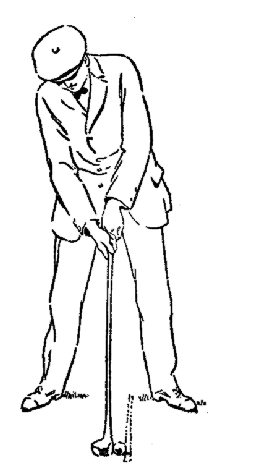 Addressing
Addressing 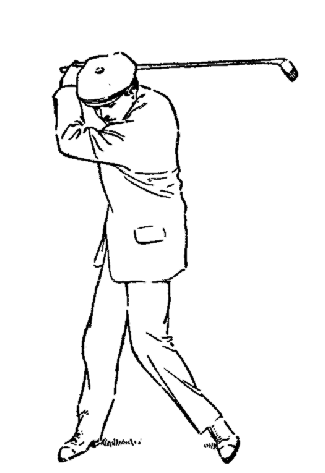 At the top of the swing
At the top of the swing 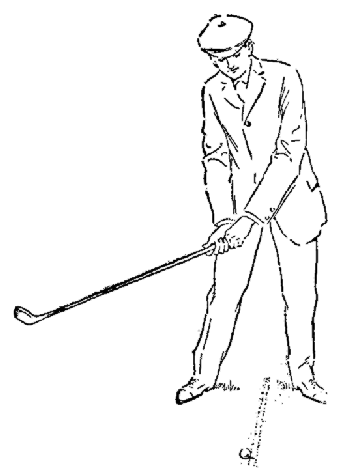 Just before the ball is struck
Just before the ball is struck Golf has but few rules. The secret of playing well consists in being able to swing the clubs with accuracy and precision. There is no game where proper form counts for more and none in which more careful preliminary instruction by an expert is so important. If one can at the very outset obtain the services of a professional or a skilful player for a few lessons, it will do far more good than ten times as many lessons after we have contracted bad habits which will have to be unlearned.
The surest way to be a poor golfer is first to think that it is a sort of "old man's game," or, as one boy said, "a game of knocking a pill around a ten-acre lot"; then when the chance to play our first game comes along to do it indifferently, only to learn later that there is a lot more to the skill of a good player than we ever realized. Another very common mistake is to buy a complete outfit of clubs, which a beginner always improperly calls "sticks," before we really know just what shape and weight of club is best adapted to our needs.
 A good outfit of clubs for golf
A good outfit of clubs for golf The common clubs in most players' outfits consist of a driver, brassie, cleek, iron, and putter. We can add to this list almost indefinitely if we wish, as there are all sorts of clubs made for various shots and with various angles. The game of golf consists in covering a certain fixed course in the fewest number of shots. We shall have to practise both for distance and accuracy. The first few shots on a hole of average length will give us an opportunity for distance. This is especially true of the first shot, or drive, but after that we make what are known as approach shots—that is to say, we are approaching the putting green where we complete the hole by "putting" the ball into the tin cup sunk into the ground. On the green we shall need to be very careful, as a stroke wasted or poorly played counts just as much against our score if the ball goes only a few feet as if we sliced or "foozled" our drive.
In scoring for golf there are two methods: Either the score of each hole is taken and the winner of a majority of holes wins the match, or the total score in counted as in "medal" or "tournament play."
"Bogie score" is a fictitious score for the course that is supposed to denote perfect playing without flukes or luck. The mysterious "Colonel Bogie" is an imaginary player who always makes this score.
